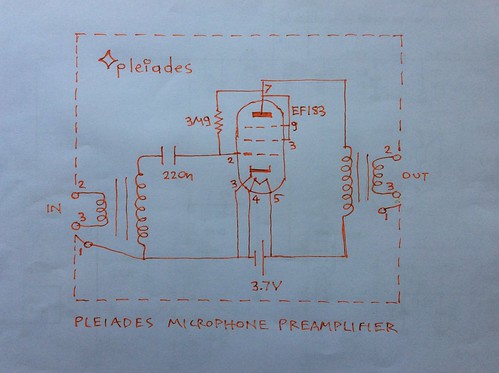Batteries, other sources of voltage should always be connected in series with a suitable fuse for safety.
Perhaps simpler is the CV2269 with just one AAA battery, ie Pleiades V1. Or using the Pleiades V6 schematic for a mic booster amplifier. Or the 2DV4 Nuvistor electron tube with an AA battery and Pleiades or pull up bias, not tried yet. A difference between Pleiades V1 and V6 is that the V6 has the output transformer directly connected to the anode, ie no plate or anode resistor. The 7586 Nuvistor has been tried with the Pleiadss V6 schematic at 3.9V at heaters and 1.3V at plate with Pleiadss bias giving excellent sound quality and low noise.

The 13CW4 should be great too as the 9V battery supply may give the opportunity of operating the electron tube at space potential or free grid, open grid, floating grid.
So by adapting the above Pleiades V6 schematic for 13CW4 use...
A 9 volt battery is used in series with a fuse for safety. Heater consumption is low for an indirect heater electron tube.
No pull up or Pleiades bias resistor may be needed.
9V suppies both heaters and plate circuit.
There are at least a few auto compensating mechanisms in this simple circuit.
1 The grid is free to assume the potential by nature. When the battery voltage drops the grid becomes less negative as the cathode emmited electrons are not that energetic near the grid. Anode current should not change much.
2 By not pull up biasing, the anode current should be small but not too small. Therefore the primary of the output transformer which is carying DC is less easily magnetically saturated. But there should be some bass drop because of a relative high internal plate resistance. So somewhat proximity effect, Flecher Munson curves, voice effort curves etc are compensated.
3 at low plate potentials the effective geometry of the electron tube changes [Atkins], μ or amplification factor decreases and there is less chance of overloading the preamplifier following the booster mic headamp.
Underheating and low plate potemtial, open grid should produce low or perhaps very low noise.
A variable inductance with respect to frequency input transformer can be used such as a Freed (see previous posts) for aproaching flat frequency response from producer's brain to listener's brain.
If 9V is not enough for operation at grid space potential then 2 or 3 batteries could be used in series and one of them one supplying the heater. The batteries can be rotated as anode consumes only microamperes.
But even with just one 9V battery a simple world class quality 13CW4, preamplifier amplifier unbalanced or balanced with transformers should be possible.
See also that the grid space potential can increase when plate voltage is applied:
http://euroelectron.blogspot.com/2018/08/the-grid-space-potential-increases-when.html
References:
Low Plate-Potential Tubes - Atkins - Radio & Television News - Jan 1957
Flat frequency response from producer's brain to listener's brain, Sound Picture recording and reproducing characteristics - D. P. Lowe, K. F. Morgan - JSMPE
No comments:
Post a Comment